Archive
Tim Gidal
- Tim
- Gidal
Ignaz Nachum Gidalewitsch, Tim N. Gidal
- 18-03-1909
- München (DE)
- 04-10-1996
- Jerusalem (IL)
- PhotographerPublisherArt Historian
Tim Gidal was a German-Jewish photographer, publisher and art historian emigrating in 1948 emigrated to New York. Besides his teaching career, he worked as a photojournalist and, along with his wife Sonia Gidal, published youth books.
Word Count: 35
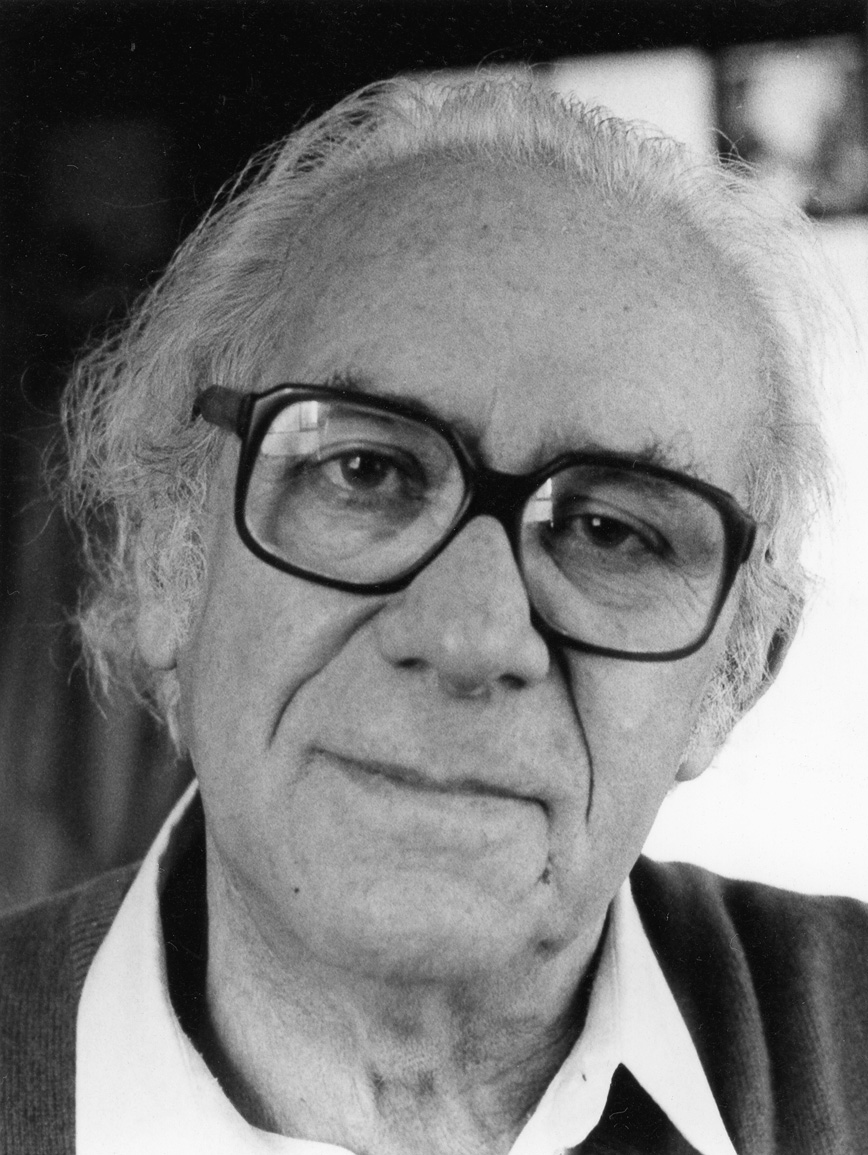
Portrait of Tim Gidal, n.d. (© Tim Gidal Archiv. Steinheim Institut. Photo: Horst Hahn). 
Cover of My village in Austria by Sonia and Tim Gidal (Pantheon, 1956). 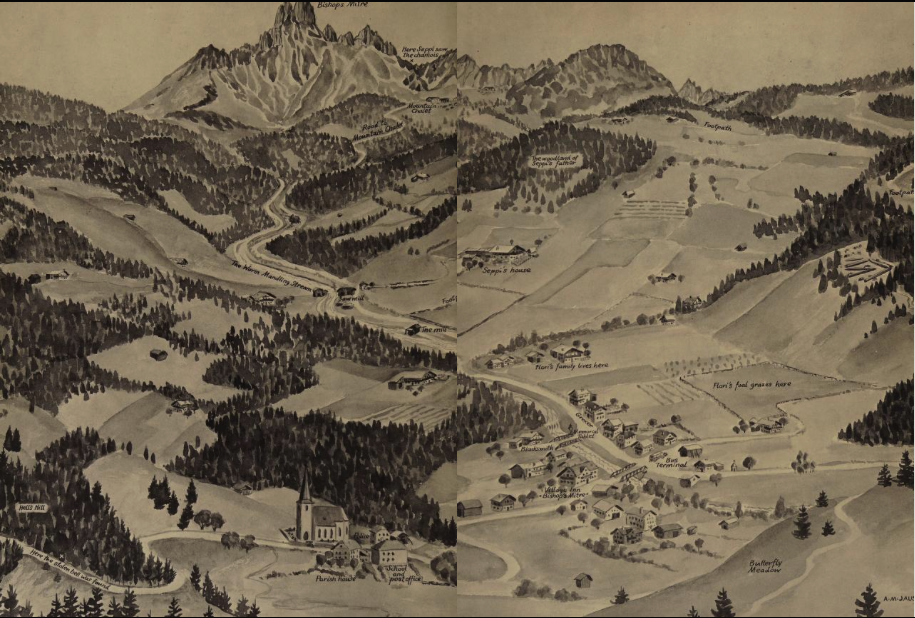
Plan of the village printed in My village in Austria by Sonia and Tim Gidal (Pantheon, 1956). 
Title page of My Village in India by Sonia and Tim Gidal (Pantheon, 1956). 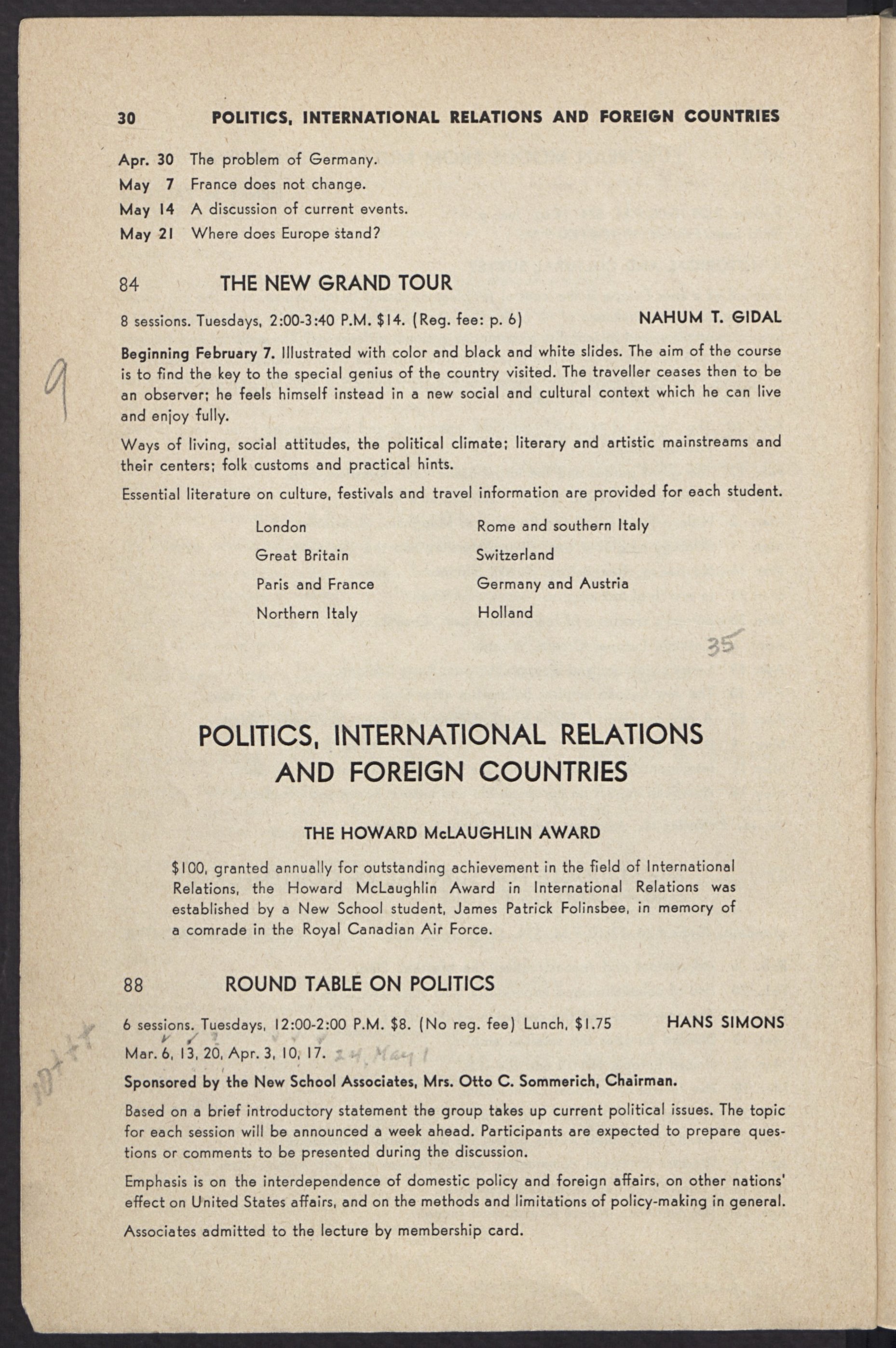
Announcement for “The New Grand Tour” course by Tim Gidal. New School Bulletin, vol. 13, no. 18, Spring 1956, p. 30 (© New School course catalog collection, NS-05-01-01. The New School Archives). 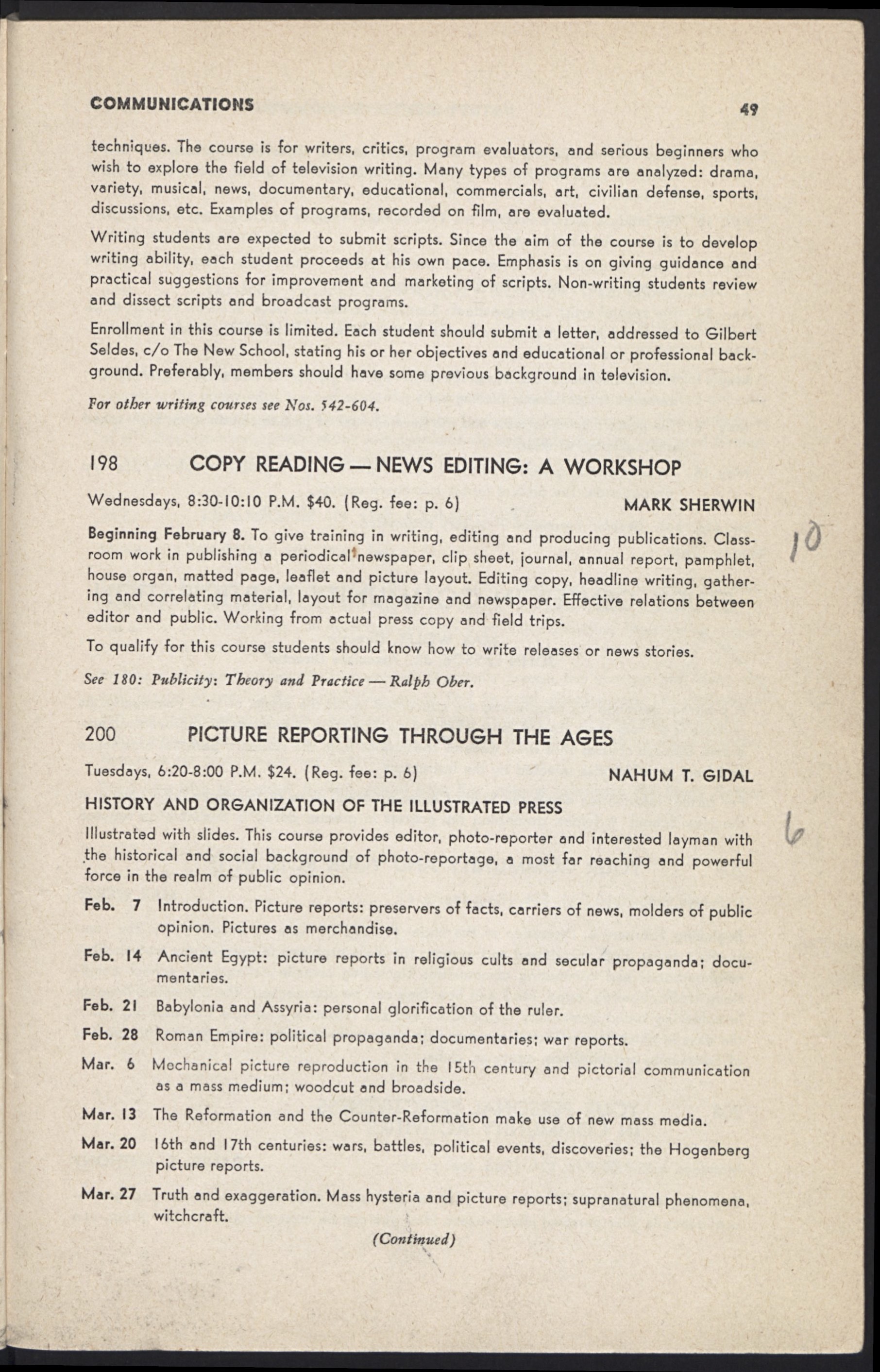
Announcement for “Picture Reporting Through The Ages” course by Tim Gidal. New School Bulletin, vol. 13, no. 18, Spring 1956, p. 49 (© New School course catalog collection, NS-05-01-01. The New School Archives). 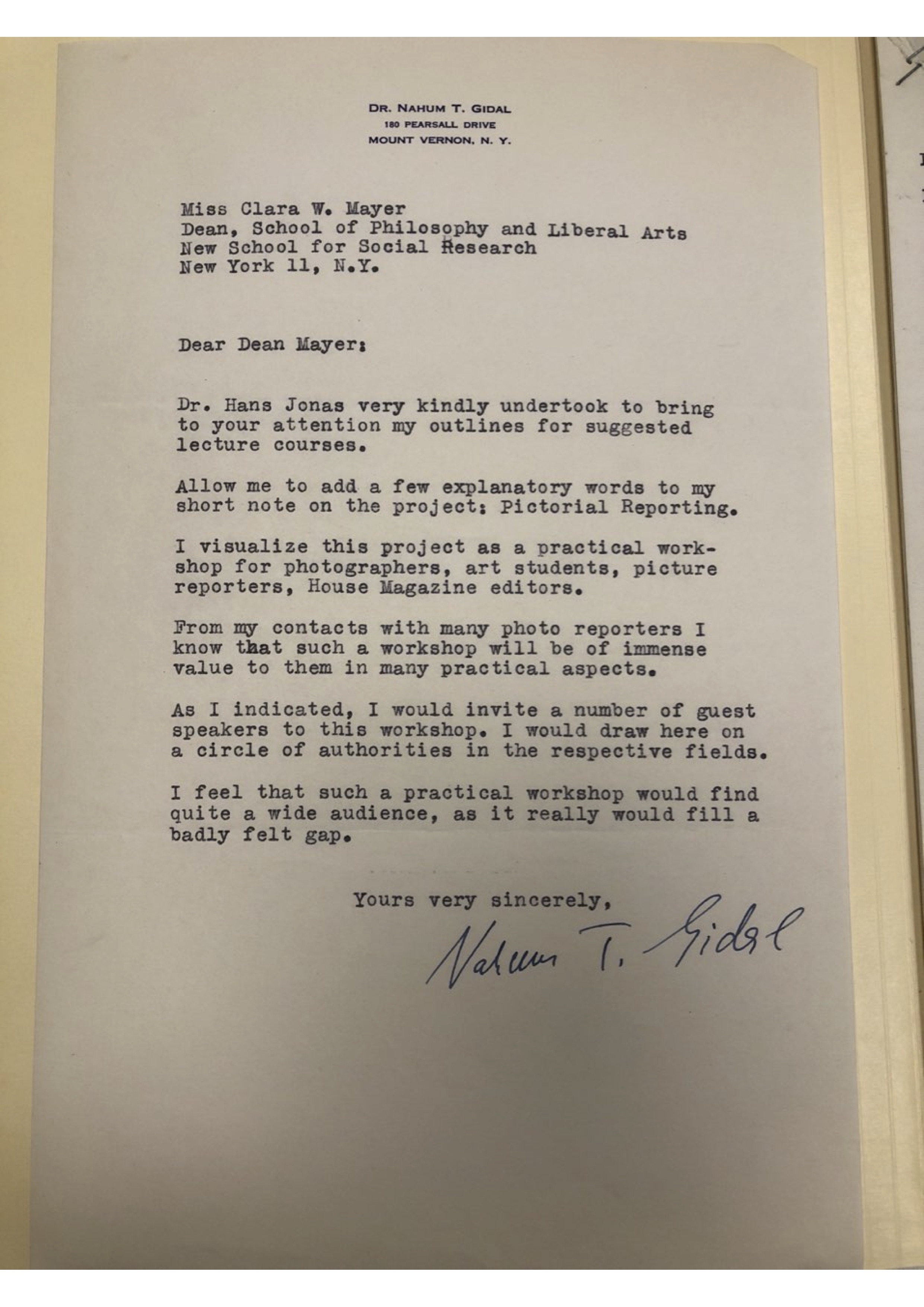
Letter from Tim Gidal to Clara W. Mayer, 1957/58 ( © Clara Mayer Papers. Gidal, Nahum T., 1957-1958, Box: 4, Folder: 27. The New School Archives, Photo: Helene Roth). Auer, Anna. Fotografie im Gespräch. Klinger, 2001.
Displaced Visions. Émigré Photographers of the 20th Century, edited by Nissan N. Perez, exh. cat. The Israel Museum, Jerusalem, 2013.
Dogramaci, Burcu, and Helene Roth. “Fotografie als Mittler im Exil: Fotojournalismus bei Picture Post in London und Fototheorie und -praxis an der New School for Social Research in New York.” Vermittler*innen zwischen den Kulturen, special issue of Zeitschrift für Museum und Bildung, vol. 86–87, 2019, pp. 13–44.
Gervais, Thierry. The Making of Visual News. A History of Photography in the Press. Translated by John Tittenson, Bloomsbury, 2017.
Milton, Sybil. “The Refugee Photographers, 1933–1945.” Kulturelle Wechselbeziehungen im Exil – Exile across Cultures, edited by Helmut F. Pfanner, Bouvier, 1986, pp. 279–293.
Schaber, Irme. “‘Die Kamera ist ein Instrument der Entdeckung…’. Die Großstadtfotografie der fotografischen Emigration in der NS-Zeit in Paris, London und New York.” Exilforschung. Ein internationales Jahrbuch, vol. 20: Metropolen des Exils, edited by Claus-Dieter Krohn et al., edition text + kritik, 2002, pp. 53–73.
Unbelichtet. Münchner Fotografen im Exil, edited by Tajana Neef, exh. cat. Jüdisches Museum München, Munich, 2010.
Werneburg, Brigitte. “LIFE: Leben in der Emigration. Deutsche Fotojournalisten in Amerika.” (unpublished manuscript, 1991). werneburg.nikha.org. Accessed 15 February 2021.
Word Count: 188
[url=https://findingaids.archives.newschool.edu/repositories/3/resources/168 ]Clara Mayer papers, NS.02.01.01, box 4, The New School Archives and Special Collections, The New School, New York, New York[/url].
Tim Gidal Photographic Collection. Steinheim Institut für deutsch-jüdische Geschichte, Essen.
Tim Nachum Gidal, Photographic Collection. Museum Folkwang, Essen.
Word Count: 64
My deepest thanks go the Tim Gidal Archive from to the Steinheim Institut für jüdische Geschichte for providing me with photographic material.
Word Count: 24
Palestine, Israel (1936–1938); London, GB (1938–1940); India,Ceylon, Palestine, Israel (1940–1942); Middle East (1942–1945); Jerusalem, Israel (1945–1947); London, GB and Basel, Schwitzerland (1947–1948); New York, US (1948–1970); Jerusalem, Israel (1970–1996).
180 Pearsall Drive, Mount Vernon, New York (1948–1970).
- New York
- Helene Roth. "Tim Gidal." METROMOD Archive, 2021, https://archive.metromod.net/viewer.p/69/2948/object/5138-9615884, last modified: 26-04-2022.
-
Kurt SafranskiPicture AgentFounding MemberTeacherCartoonistPublisherIllustratorNew York
Kurt Safranski was one of the founding members of the Black Star photo agency, a teacher at the New School for Social Research and the author of photojournalistic articles and books.
Word Count: 31
Josef BreitenbachPhotographerNew YorkOn arriving in New York in 1941, the German photographer Josef Breitenbach tried to restart as a portrait, street and experimental photographer, as well as a teacher of photo-history and techniques.
Word Count: 30
Lisette ModelPhotographerNew YorkLisette Model was an Austrian-born photographer who lived in New York with her husband Evsa Model after emigrating from France. Her street photographs capturing the curiosities of everyday life quickly caught the interest of museums and magazines.
Word Count: 37
Alexey BrodovitchPhotographerArt DirectorGraphic DesignerNew YorkAlexey Brodovitch was a Belarus-born émigré graphic artist, art director and photographer who, from 1933, worked in New York for Harper’s Bazaar magazine and at the New School for Social Research.
Word Count: 31
Charles LeirensPhotographerMusicianMusicologistNew YorkCharles Leirens was a Belgian-born musician and photographer who emigrated to New York in 1941. While publishing two books on Belgian music, he also gave courses in musicology and photography at the New School for Social Research.
Word Count: 36
Marion PalfiPhotographerNew YorkMarion Palfi was a German émigré photographer who lived in New York from the 1940s to the 1960s. Her photographic engagement in social and political topics made her name for her use of the camera to draw attention to social injustices.
Word Count: 41
Lotte JacobiPhotographerNew YorkIn October 1935 the German émigré photographer Lotte Jacobi, together with her sister Ruth Jacobi, opened a photo studio on 57th Street. The two sisters had to leave their parents' photo studio in Berlin in the 1930s and emigrated to New York.
Word Count: 41
Ellen AuerbachPhotographerNew YorkWhen she arrived in New York in 1937, the German-born photographer Ellen Auerbach (formerly Rosenberg) had already passed through exile stations in Palestine and Great Britain.
Word Count: 25
Lilo HessPhotographerNew YorkThe German émigré Lilo Hess was an animal photographer working for the Museum for Natural History and the Bronx Zoo, as well being a freelance photographer and publisher of children's books.
Word Count: 31
Carola GregorPhotographerSculptorNew YorkThe German émigré photographer Carola Gregor was an animal and child photographer and published some of her work in magazines and books. Today her work and life are almost forgotten.
Word Count: 30
Trude FleischmannPhotographerNew YorkTrude Fleischmann was an Austrian-Jewish portrait and dance photographer who emigrated in 1939 to New York, where she opened a studio in Midtown Manhattan with the photographer Frank Elmer.
Word Count: 28
Henry RoxPhotographerSculptorNew YorkHenry Rox was a German émigré sculptor and photographer who, in 1938, arrived in New York with his wife, the journalist and art historian Lotte Rox (née Charlotte Fleck), after an initial exile in London. Besides his work as a sculptor, he began creating humorous anthropomorphised fruit and vegetable photographs.
Word Count: 50
Chinatown U.S.A.PhotobookNew YorkChinatown U.S.A. is a photobook published by the German émigré photographer Elizabeth Coleman in 1946 focusing on American-Chinese communities in New York and San Francisco.
Word Count: 26
5th AvenuePhotobookNew York5th Avenue was the first photobook by Fred Stein and was created in 1947 with the publishing house Pantheon Books.
Word Count: 19
J.J. Augustin Incorporated PublisherPublishing HouseNew YorkJ.J. Augustin was a German publishing house in Glückstadt with a long history, going back to 1632. In 1936 the American branch opened in New York with a large artistic and cultural focus.
Word Count: 33
Pantheon BooksPublishing HouseNew YorkPantheon Books was a publishing house founded in 1942 by the German émigré Kurt Wolff (1887–1963) and aimed at the exiled European community in New York.
Word Count: 24
New School for Social ResearchAcademy/Art SchoolPhoto SchoolUniversity / Higher Education Institute / Research InstituteNew YorkDuring the 1940s and 1950s emigrated graphic designers and photographers, along with artists and intellectuals, were given the opportunity to held lectures and workshops at the New School for Social Research.
Word Count: 31
Werner WolffPhotographerNew YorkWerner Wolff was forced to leave Germany in 1936 due to his Jewish background and emigrated via Hamburg to New York, where he could follow his career as photographer and photojournalist.
Word Count: 30
Erika StonePhotographerNew YorkErika Stone is a German émigré, who moved to New York with her parents and sister in December 1936, at the age of 12. She went on to carve out a career as photographer.
Word Count: 32
Fred SteinPhotographerLawyerNew YorkAlways accompanied by his camera, the German émigré photographer Fred Stein discovered New York City during the 1940s and 1950s. His pictures provide an human and multifaceted view of the metropolis.
Word Count: 31
Fritz HenlePhotographerNew YorkFritz Henle was a German Jewish photographer who emigrated in 1936 to New York, where he worked as a photojournalist for various magazines. He also published several photobooks of his travels throughout North America and Asia.
Word Count: 35
Kurt KornfeldPublisherPicture AgentFounding MemberNew YorkKurt Kornfeld was a publisher and literary agent and a founding member of the Black Star photo agency in New York City after his emigration in 1936 to New York.
Word Count: 29
Ernest MayerPicture AgentFounding MemberPublisherNew YorkErnest Mayer was co-founder of the Black Star Publishing Company photo agency, which built a network for émigré photographers and the American magazine scene from the mid-1930s until the end of the 1950s.
Word Count: 34
Black Star AgencyPhoto AgencyNew YorkThe German émigrés Kurt S(z)afranski, Ern(e)st Mayer and Kurt Kornfeld founded Black Star in 1936. The photo agency established was a well-run networking institution in New York.
Word Count: 31
Black Star Publishing Company LondonPhoto AgencyLondonThe 1936 New York-founded Black Star Publishing Company photo agency opened a European branch in London the same year in response to the high demand for foreign images in the U.S.
Word Count: 31
“The Life of a Station.”PhotoessayLondonPhotographer Tim N. Gidal’s first reportage for Picture Post magazine after his emigration to London was devoted to Victoria Station, observing travellers and their companions as they depart and arrive.
Word Count: 31